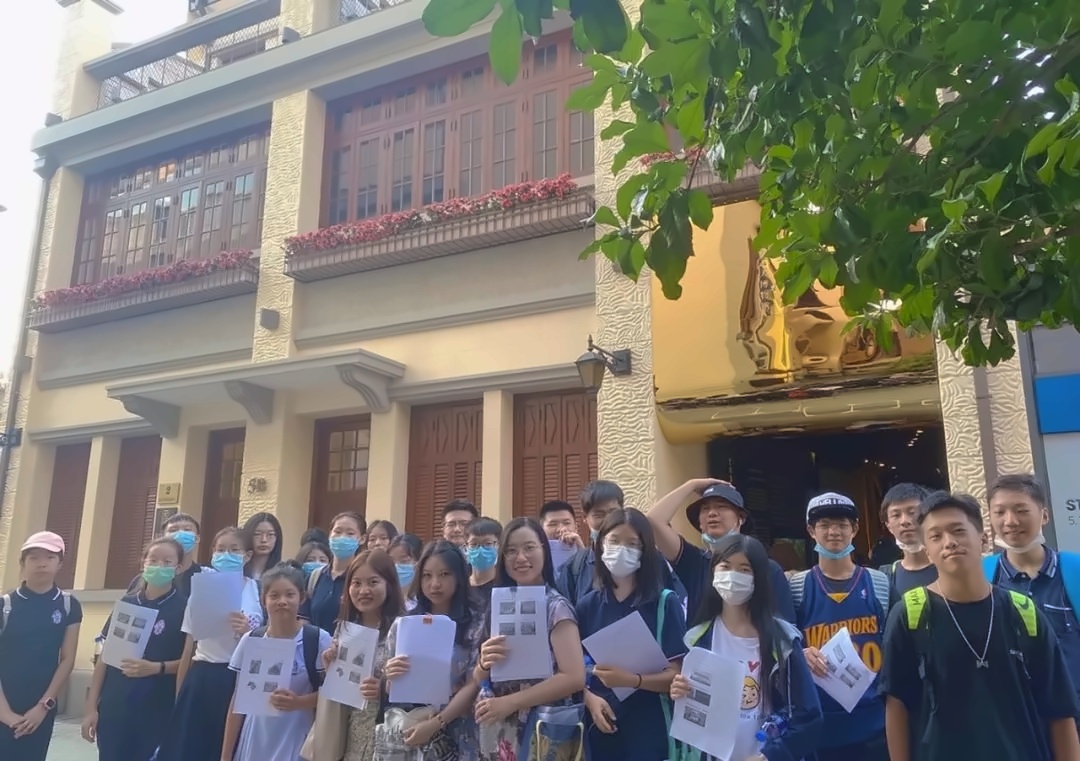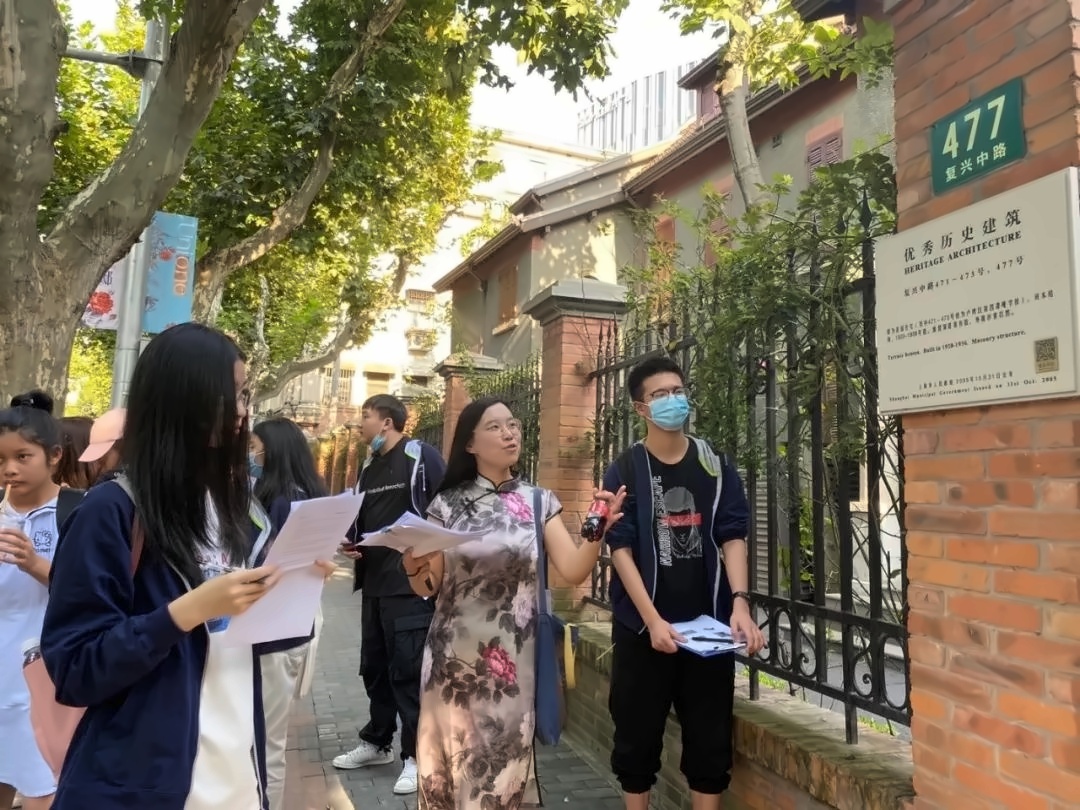全国统一学习专线 8:30-21:00
来源: 上海诺科学校 编辑:佚名
标化课堂活动1:单词记不住?实物来帮忙——伫立眼前的建筑
同学们说,建筑类单词即使死记硬背,也还是怎么都记不住,做阅读只能靠猜。在思南博物馆中,同学们中英对照,了解建筑名称与其英文释义,认真地记录着陌生的单词和词组,与建筑的历史故事一同沉浸在时光流逝中。
标化课堂活动2:建筑记录历史,我们记录建筑
「建筑是凝固的音乐,音乐是流动的建筑。」
我们在街头邂逅造型独特的建筑作品,在纸上探寻它们存在的意义。在思南博物馆内,同学们仔细阅读着思南的前世今生,纷纷记下动人的句子。厚重的建筑物似乎在白字黑字间灵动起来了。

上海诺科学校标化行走课堂
SINAN MANSIONS
AN OPEN-AIR MUSEUM OF COLONIAL ARCHITECTURE IN THE HEART OF SHANGHAI
Sinan Road is one of the best old streets in Shanghai to escape from the bustling city, with western style villas, small delicate shops and restaurants, in the shade of tall plane trees. It joins Huaihai Road to Taikang Road in the Former French Concession. Sinan Road was built in 1914 and named 'Rue Massenet' by the French Concession authorities to commemorate the famous French musician who died on August 13,1912. Tourists walking in the streets of the ex-French Concession cannot miss the plaques attached to colonial buildings informing about their year of construction and their original function, but not everybody knows that a neighborhood of the ex-French Concession has been transformed into an open-air museum. The Sinan Open-air Museum offers the opportunity to understand how European colonial heritage is managed and reframed in contemporary Shanghai.
The Sinan Open-Air Museum owes its name to the street on which it is located, Sinan Road (思南路, Sinan lu), formerly known as Rue Massenet, built in 1912 after the third expansion of the French Concession. Originally a rural village, the area was developed by the French authorities in order to meet the needs of the nouveau-rich, politicians and cultural personalities for elegant houses in the city. The neighbourhood around Rue Massenet was the first one in Shanghai to be entirely designed by architects and urban planners. The Belgian real estate company Yipin developed the first section of the neighbourhood, still called Yipin Village (Yipin cun, 义品村, between 1912 and 1936), but more mansions were added in the nearby area. Only houses with European features were allowed (Fig. 2). This explains the variety of styles represented among the fifty-one buildings of the Open-Air Museum, including individual garden houses, modern mid-rise apartments, stacked garden houses, etc.
Famous Chinese and foreign personalities lived and worked in Rue Massenet and the nearby streets: international Peking opera star Mei Lanfang 梅兰芳 (1894-1961) lived in 87 Sinan Road between 1933 and 1959; poet Liu Yazi 柳亚子 (1887-1958) lived in 517 Middle Fuxing Road between 1932 and 1940; and general Feng Yuxiang 冯玉祥 (1882-1948) had property rights over 517 Middle Fuxing Road (now Sinan Books, a celebrated bookstore and intelligentsia's meeting spot) (Fig. 3). Zhou Enlai 周恩来 (1898-1976) also lived here, and his house is now a museum (73 Sinan Road). During the Second Sino-Japanese War (1937-1945) most of the inhabitants of these mansions left Shanghai to move to Hong Kong. While the Sinan Open-Air Museum provides the opportunity to visitors to know more about the history of the neighbourhood, its establishment should also be understood as a marketing strategy. Speaking about the Open-Air Museum to a journalist of China Daily, the brand director of Sinan Mansions stated that "the prominence of Sinan Mansions stems from its links with celebrities and politicians." By emphasizing the connection between the buildings and the Chinese personalities who lived in them, the Museum supports the "cultural Sinan" brand that developers created to sell the luxury services offered by Sinan Mansions. For instance, the Yonghe Group's marketing campaign for selling apartments in this neighborhood is "History inspires people".
标化课堂活动3:它们好有style啊,可style是……?
思南公馆区域囊括了独立式花园住宅、联排式住宅、联立式花园住宅、新式里弄住宅、花园里弄住宅、现代公寓式住宅、外廊式住宅、带内院独立式花园住宅等8种住宅类型,足以使我们领略到不同建筑类型的独特魅力。
由思南公馆的25号楼改建而成的一家思南书局,在这个娱乐至死、聒噪浮华的时代,犹如一位冷静的旁观者,怀揣着一屋智慧,静候与有缘人相逢。学生们游走在这座用书架打造的迷宫中,每个人都能在其中找到自己安身的角落。
标化课堂活动4:走近托福写作——历史建筑or摩天大楼?
Should a city preserve its old, historic buildings or destroy them and replace them with modern ones? Use specific reasons and examples to support your opinion.
保存历史建筑的必要性在于其文化意义、教育意义和商业意义(比方开发旅游业)。而撤除则是出于城市土地需求的理想性来思索,比方开发住房和商业场所。
Culturally-a community is richer for having the tangible presence of past eras and historic styles.
Economically-a community benefits from increased property values and tax revenues when historic buildings are protected and made the focal point of revitalization and when the community is attractive to visitors seeking heritage tourism opportunities.
Socially-a community benefits when citizens take pride in its history and mutual concern for the protection of the historic building fabric.
Developmentally-a community benefits from having a concerted and well-defined planning approach for the protection of historic buildings while accommodating healthy growth.
Environmentally-a community benefits when historic buildings are restored or rehabilitated rather than demolished and disposed of in the community landfill.
Educationally-a community benefits through teaching local heritage and through the understanding of the past and the culture by its citizens.
你的选择是?

行走课堂
学生活动感想
Pre2A 顾同学:
9月5日,诺科举行了行走课堂。这次我们来到了思南公馆——上海成片花园住宅最集中的区域之一。
在思南公馆的博物馆中,我们了解到了思南公馆由于经过了历史的变迁,形成了各式各样的独立、联排形式的花园住宅,可以说是上海历史建筑的缩影。
在自由活动时间的时候,老师带着我们来到了思南书局,那是一个十分有历史感的地方。在地下一层的角落有几张不起眼的书桌,当我坐下时,瞬间就感受到那种书海遨游的学习氛围,是我梦想的学习之地没错了。我很高兴有机会能和同学们一起参与到这次活动当中。
Pre2D 刘同学:
9月5日,诺科学校组织我们去思南公馆参观学习。通过这次学习,我了解到了思南公馆丰富的历史背景和文化底蕴。本次活动组织者Emily老师知识渊博、认真负责,在参观期间为我们介绍了建筑学科的词汇,也将托福写作引入其中,讲解了如何书写关于“是否需要保留老建筑”的写作策略。非常感谢学校给我们提供了这次宝贵的学习机会,让我们在行走中吸收书本以外的知识。希望今后学校能多多组织类似的活动。
Pre2A 李同学:
周末,我有幸参加了诺科宝山校区的行走课堂,这一次的目的地是思南公馆。从地铁站走到公馆,一路上经过了清朝时期的法租界,见到了各式各样的建筑物。有Romanesque雄伟的罗马式建筑,3-story Vila闲适的三层洋楼,Reinforced concrete structure也有近现代的钢筋混凝土建筑。在思南公馆有一个集市,非常的热闹,人山人海;相较之下,典雅的公馆本身显得更加的富有书香气。公馆的其中一个单元楼,被改造成了一个三层楼的书店,叫思南书局,这也使得整个公馆给人一种读书人的感觉,与热闹的人群产生了鲜明对比。正如上海是一个国际大都市,融合了各式各样的人;在思南公馆,你能看到一种不同文化和人物的碰撞,甚至是思想与精神层面的。So I want to conclude that Life is architecture and architecture is the Mirror or life!
Pre2D 朴同学:
思南公馆是中国上海市中心唯一一个以成片花园洋房的保留保护为宗旨的项目,坐拥51栋历史悠久的花园洋房,同时汇聚了独立式花园洋房、联立式花园洋房、带内院独立式花园洋房、联排式建筑、外廊式建筑、新式里弄、花园里弄、现代公寓等多种建筑样式,是上海近代居住类建筑的集中地。从宿舍出发的我,一路上一直在想思南公馆的模样是否真的如其所说的那么美丽。到达了目的地,我们先是拿了两份卷子有助我们学习和更好的浏览思南公馆。在Emily老师的带领下,我们参观了博物馆、书局、夜市等等,顺便也品尝了不少美⻝。最让我记忆深刻的是博物馆,曾经竟有不少名人住过思南公馆,Emily老师还给我们讲了托福作文中遇到这样的建筑应该如何写作,受益匪浅。此次思南公馆一游了解了不少之前的历史,学到了一些古建筑单词和应对写作的技巧,让人觉得不虚此行(^-^)V
Pre2D 李同学:
伴着“墨绿梧桐,朱红洋房”,我们相约在思南公馆。不熟悉的我们对于陌生的洋房有了些许疑惑。但是,在带队老师Emily的指导下,我们变得“大胆”起来:主动参观博物馆,记录历史小知识,参加小活动,阅览群书等。对了,在此之前,我们的Ada老师还重点教了我们一些标化类单词,这对以后我们的标化考试有了进一步的帮助,我的单词积累又有了些许小提升呢!在这次行走课堂中,最让我印象深刻的,是关于博物馆的历史:在博物馆里,我们了解到了各个不同行业的人们对于思南公馆不同的保护和传承方式;还学习了思南公馆在现代存在的意义,让我难忘的是这一句话:我们传承历史的方式,就是与你们一起继续创造历史。历史对于当代的意义,不仅是回忆,还是传承与发扬。我想,这就是思南公馆存在的重要价值吧。
学生家长寄语
Pre2A 肖同学家长:
非常支持女儿去参加思南公馆人文行走活动,因为这是一个非常有意义的经历。孩子在参观中了解上海的历史、建筑文化的同时又学习到相应的英文,在参观中去扩充知识面,寓教于乐,希望以后学校能多提供这种机会,带孩子走出去,在游中学,在游中滋养心灵。
Pre2D 刘同学家长:
馆驿错落,功能各异,八方十国争艳浦西。不见沧桑。思南之行点点滴滴都是给孩子对历史、对现代文明增加理解。这样的活动非常重要,孩子很喜欢,赞不绝口。
上海诺科学校报名、校园参观及了解招生动态,请: ,或通过下方报名通道登记。